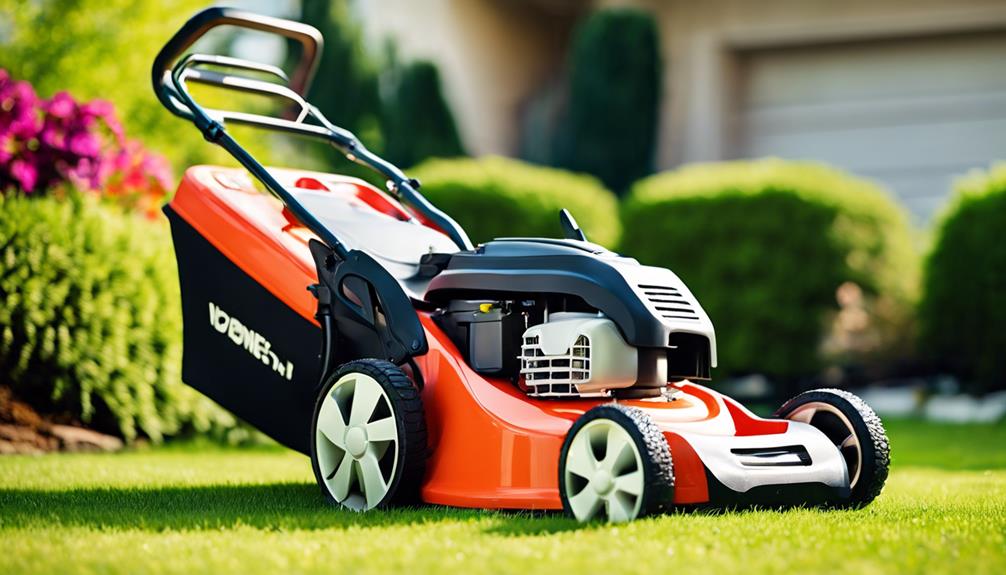
What Are the Best Lawn Care Services for Businesses?
15 March 2025
Why You Need a Seasonal Garden Cleanup Checklist?
15 March 2025Busy individuals can maintain a healthy lawn by implementing efficient care strategies. Invest in essential tools, such as a quality mower and soil moisture meter, to streamline tasks.
Adopt a consistent watering schedule, providing deep hydration weekly to minimise effort. Mow regularly, but only when the grass exceeds the ideal height, to avoid overworking. Consider mulching to reduce mowing frequency and retain moisture.
Utilise automated irrigation systems for convenience and establish a seasonal care plan to stay organised. For those wishing to enhance results with minimal time investment, there are even more effective strategies available.
Quick Tips for Lawn Care
To maintain a healthy lawn, having the right tools at your disposal is vital.
Furthermore, implementing efficient watering techniques can greatly improve your lawn's vigour while conserving resources.
This section will investigate both important tools and effective watering strategies to guarantee optimal lawn care.
Essential Tools Required
A well-maintained lawn requires a few vital tools that can make the difference between a lacklustre yard and a vibrant outdoor space.
To begin with, a high-quality lawn mower is fundamental for achieving an even cut, which promotes healthy grass growth. A sturdy rake aids in collecting debris and leaves, ensuring a tidy appearance.
Furthermore, a reliable strimmer allows for precise edging along pathways and flower beds, enhancing the overall aesthetic. A soil aerator is invaluable for improving drainage and nutrient absorption, while a spreader facilitates the even distribution of fertilisers and seeds.
Efficient Watering Techniques
Effective watering techniques are crucial for maintaining a lush and healthy lawn. To optimise water usage, consider implementing deep and infrequent watering practices. Aim for approximately one inch of water per week, either through rainfall or irrigation, and apply it less frequently to encourage deep root growth.
Early morning is the ideal time for watering, as it reduces evaporation and the risk of fungal diseases. Utilise a soaker hose or drip irrigation system for targeted hydration and efficiency.
Furthermore, monitor your soil moisture with a soil moisture meter to prevent overwatering. Ultimately, adjust your watering schedule seasonally, recognising that cooler temperatures and rainfall may reduce the need for regular irrigation.
Master these techniques to cultivate a robust and resilient lawn.
Lawn Maintenance Frequency
Maintaining a healthy lawn requires a consistent approach to maintenance frequency that considers soil quality and health, watering schedules, and fertilisation techniques.
Regular assessments of these factors enable homeowners to tailor their care routines effectively.
Understanding the timing and consistency in these areas is essential for promoting long-term lawn health.
Soil Quality and Health
Soil quality and health are crucial for achieving a lush, vibrant lawn. To master your lawn care, it is important to focus on the condition of the soil, which directly influences growth and resilience.
Here are three critical aspects to evaluate:
- pH Level: Test your soil pH regularly; most grasses thrive in a range of 6.0 to 7.0. Adjust as necessary to improve nutrient availability.
- Organic Matter: Incorporate compost or well-rotted manure to enrich soil structure and fertility, promoting healthier root systems.
- Nutrient Balance: Conduct a soil test to identify nutrient deficiencies. Apply balanced fertilisers tailored to your lawn's specific needs, ensuring ideal growth and wellness.
Watering Schedule Consistency
While a lush lawn requires multiple elements to thrive, establishing a consistent watering schedule is essential for maintaining its health and appearance.
A well-timed watering routine not only conserves water but also promotes deep root growth, enabling your grass to withstand stressors.
To enhance the benefits of your watering schedule, consider the following:
- Frequency: Water your lawn deeply but infrequently, ideally 1-2 times per week, to encourage root development.
- Timing: Water early in the morning to minimise evaporation and fungal diseases, ensuring the grass absorbs moisture effectively.
- Observation: Monitor your lawn's response; adjust the schedule based on weather changes and lawn growth patterns for optimal health.
Fertilization Timing and Techniques
A well-timed fertilisation schedule is vital for promoting a vibrant and healthy lawn. Understanding when and how to fertilise will guarantee peak nutrient uptake and growth.
Consider the following techniques:
- Seasonal Application: Fertilise in early spring and autumn, aligning with grass growth cycles to optimise nutrient absorption.
- Soil Testing: Conduct a soil test to determine specific nutrient needs, tailoring your fertilisation to improve soil health.
- Slow-Release Fertilisers: Utilise slow-release formulations to provide a steady supply of nutrients, reducing the risk of leaching and promoting sustained growth.
Choose the Right Tools
Selecting the appropriate tools is vital for efficient lawn care.
Fundamental tools such as quality mowers and aerators can greatly affect the health and appearance of your lawn.
Furthermore, understanding ideal mowing heights and proper aeration techniques will promote deeper root systems and comprehensive resilience.
Select Essential Lawn Tools
Choosing the right tools is vital for effective lawn care, as the appropriate equipment can significantly enhance both efficiency and results.
For busy individuals striving for a pristine lawn, investing in essential tools is crucial. Consider these three must-have items:
- Lawn Mower: A high-quality mower suited to the size of your lawn ensures precise cutting while saving time.
- String Trimmer: This versatile tool allows for detailed edging and trimming in hard-to-reach areas, providing a polished finish.
- Rake: A robust rake is indispensable for debris removal and promoting healthy grass growth by aerating the soil.
Selecting these essential tools will improve your lawn care routine, enabling you to maintain a beautiful garden with minimal effort.
Mow at Optimal Height
Mowing at the ideal height is vital for maintaining a healthy and vibrant lawn. The best cutting height promotes root development and helps grass withstand environmental stressors.
To master this key aspect of lawn care, consider the following:
- Know Your Grass Type: Different grass varieties thrive at specific heights. For example, cool-season grasses typically prefer a height of 6 to 10 centimetres, while warm-season grasses do well at 4 to 8 centimetres.
- Adjust Mower Settings: Regularly calibrate your mower's blade height to ensure consistent cutting, adapting it seasonally as growth patterns change.
- Avoid Over-Mowing: Never remove more than one-third of the grass blade at a time to prevent shock and promote healthy regrowth.
Aerate for Deeper Roots
Aeration is a crucial step in promoting deeper root growth and enhancing the overall health of your lawn. Choosing the right tools is essential to achieving optimal results.
Here are three important aeration tools to consider:
- Core Aerator: This machine removes soil plugs, allowing air, water, and nutrients to penetrate deeper into the soil.
- Spike Aerator: A simpler tool that creates holes in the soil. Although it is less effective than core aeration, it can be used for minor tasks.
- Manual Aerator: Ideal for small areas, this handheld tool allows for precise aeration, particularly in compacted spots.
Investing in the right equipment will facilitate effective aeration, ensuring your lawn develops robust root systems and thrives throughout the seasons.
Time-Saving Lawn Care Strategies
Effective lawn care doesn't have to be a time-consuming task. Implementing efficient strategies can significantly reduce the time spent maintaining your lawn. Consider the following time-saving techniques to enhance your lawn care routine:
| Strategy | Description |
|---|---|
| Mulching | Reduces mowing frequency and retains moisture. |
| Smart Scheduling | Mow during cooler parts of the day to save time. |
| Automatic Irrigation | Utilise timers to ensure consistent watering without manual effort. |
| Fertilisation Timing | Apply slow-release fertilisers to minimise application frequency. |
| Tool Organisation | Keep tools in a designated area to streamline access and usage. |
Garden Pest Control Techniques
Effective garden pest control is crucial for maintaining a healthy landscape while minimising harm to the environment.
Natural insect repellent sprays and organic pest control methods provide viable alternatives to chemical treatments.
Furthermore, the use of beneficial nematodes can target specific pests, enhancing the overall health of your garden.
Natural Insect Repellent Spray
For homeowners looking to protect their gardens without resorting to harsh chemicals, a natural insect repellent spray can be an excellent solution.
These sprays often utilise essential oils and other natural ingredients to effectively deter pests while remaining safe for the environment.
To create an effective natural insect repellent spray, consider the following components:
- Essential Oils: Oils such as peppermint, neem, and lavender possess insect-repelling properties.
- Dilution: Combine essential oils with a carrier liquid, such as water or witch hazel, to ensure safe application.
- Application Frequency: Regularly reapply the spray, particularly after rain, to maintain its effectiveness.
Organic Pest Control Methods
How can gardeners maintain a thriving ecosystem while managing pests?
Employing organic pest control methods is vital for preserving beneficial organisms while effectively addressing pest issues. Here are three effective techniques:
- Companion Planting: Strategically planting certain species together can deter pests. For example, marigolds repel nematodes and aphids, fostering a healthier garden environment.
- Homemade Solutions: Use natural ingredients, such as soap and water, to create effective insecticidal sprays targeting soft-bodied pests without harming beneficial insects.
- Neem Oil: Extracted from the seeds of the neem tree, this organic compound disrupts pest life cycles and is effective against numerous insects while being safe for humans and pets.
Implementing these methods not only safeguards your plants but also enhances the overall ecological balance of your garden.
Beneficial Nematodes for Pests
Among the myriad of pest control techniques, beneficial nematodes stand out as a natural and effective solution for managing garden pests.
These microscopic worms target harmful insects in the soil, offering a sustainable alternative to chemical pesticides. Their application can greatly enhance your gardening efforts with minimal time investment.
Here are three key benefits of using beneficial nematodes:
- Targeted Action: They specifically seek out and infect pests such as grubs and larvae, efficiently reducing their populations.
- Environmental Safety: As a non-toxic option, they pose no risk to humans, pets, or beneficial insects.
- Ease of Use: Simply mix with water and apply to infested areas, integrating seamlessly into your lawn care routine.
Utilising beneficial nematodes empowers gardeners to maintain pest control with minimal disruption.
Lawn Care Time Management Tips
Effective lawn care requires not only skill but also strategic time management to enhance efficiency.
By mowing less frequently while ensuring optimal results, automating watering schedules with timers, and creating a well-structured maintenance calendar, homeowners can significantly reduce their effort.
These tips will assist you in maintaining a healthy lawn while freeing up valuable time for other activities.
Mow Less Frequently, but Effectively
Maintaining a lush, healthy lawn does not always require frequent mowing; in fact, mowing less often can lead to better results if done correctly.
By adjusting your mowing strategy, you can optimise your efforts while ensuring your lawn flourishes. Consider these key practices:
- Mow at the Right Height: Set your mower to the appropriate height for your grass type, allowing deeper roots to develop and improving drought resistance.
- Mow When Necessary: Assess grass growth regularly, and only mow when the grass reaches one-third above the ideal height, promoting stronger blades.
- Sharpen Mower Blades: Keep mower blades sharp to ensure clean cuts, reducing stress on the grass and minimising disease susceptibility.
Implementing these practices will enhance your lawn's health while saving valuable time.
Automate Watering With Timers
Automating your lawn's watering schedule with timers can significantly streamline your lawn care routine while ensuring consistent hydration.
This not only conserves water but also promotes healthier grass growth. To effectively implement this strategy, consider the following steps:
- Select the Right Timer: Choose a programmable timer that allows for multiple watering cycles and duration settings to accommodate varying weather conditions.
- Set Ideal Watering Times: Programme your timer to water early in the morning or late in the evening to minimise evaporation and enhance absorption.
- Monitor and Adjust: Regularly check your lawn's moisture levels and adjust the timer settings based on seasonal changes or rainfall to maintain optimal health.
Efficient Lawn Care Scheduling
Creating a well-structured lawn care schedule can greatly enhance the efficiency of your maintenance efforts. A strategic approach not only saves time but also improves the overall health of your lawn.
Consider implementing the following steps:
- Seasonal Planning: Identify key tasks for each season, such as aeration in spring and leaf clearance in autumn, to align your efforts with the natural growth cycle.
- Task Prioritisation: Establish a hierarchy of tasks based on urgency and impact, focusing on high-priority activities like fertilisation and pest control.
- Time Block Allocation: Dedicate specific blocks of time each week for lawn care activities, ensuring consistency and allowing for adjustments based on weather conditions.
Why Choose TKL Birmingham Gardener
When it comes to lawn care in Birmingham, choosing TKL Birmingham Gardener ensures that your outdoor space receives the expert attention it truly deserves.
Our team comprises seasoned professionals who possess extensive knowledge of local climate and soil conditions, guaranteeing tailored care for your lawn. We utilise advanced techniques and equipment to enhance the health and aesthetics of your landscape efficiently.
Moreover, TKL Birmingham Gardener prioritises sustainable practices, employing environmentally friendly solutions that promote long-term lawn health.
Our commitment to excellence is evident in our personalised service, which allows us to address specific needs and preferences.
By opting for TKL, you are investing in a transformative lawn care experience that elevates your property while saving you precious time.
Trust us for unparalleled results and a thriving outdoor environment.
Common Lawn Care Questions
Lawn care enthusiasts often have a myriad of questions that can arise when maintaining a healthy and vibrant garden. Common inquiries include the ideal frequency for mowing, the perfect height for grass, and the best time for fertilisation.
Many also wonder about the most effective methods for pest control and disease prevention. Understanding soil health is essential; consequently, questions about soil testing and amendments frequently arise.
Furthermore, enthusiasts often seek clarity on watering practices, particularly in varying weather conditions. Addressing these concerns requires a nuanced understanding of grass types, local climate, and seasonal changes.
Plan Seasonal Lawn Care Tasks
A well-structured seasonal plan is essential for effective lawn care, as it ensures that critical tasks are performed at the optimal times throughout the year.
This strategic approach not only improves the health of your lawn but also optimises your time investment.
To master seasonal lawn care, consider the following tasks:
- Spring Preparation: Aerate the soil and apply pre-emergent herbicides to prevent weeds.
- Summer Maintenance: Adjust mowing height to encourage deeper root growth and regularly inspect for pests.
- Autumn Renovation: Reseed bare patches and apply a nitrogen-rich fertiliser to promote recovery.




